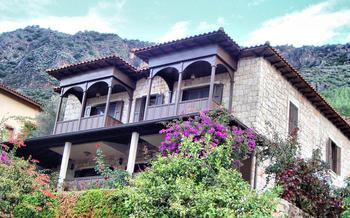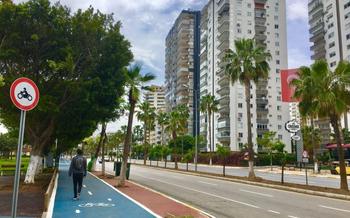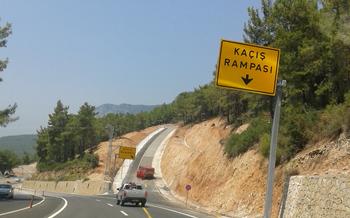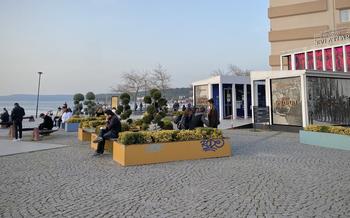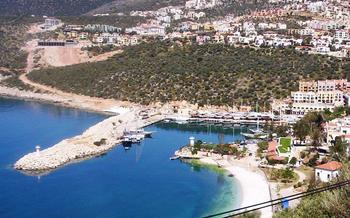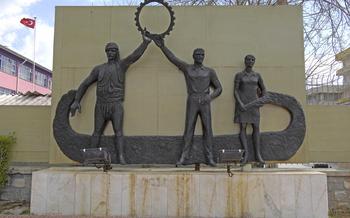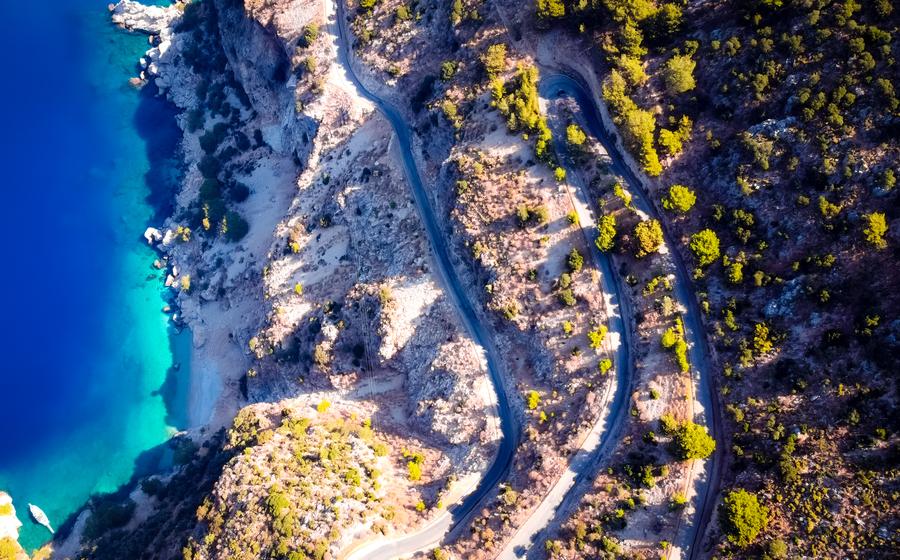
Sidyma Ancient City
- Sidyma Ancient City: A Hidden Gem in Ölüdeniz
- Unveiling the Ruins of Sidyma
- A Journey Through Time
- The Theater of Sidyma: A Masterpiece of Architecture
- Exploring the Temples and Shrines
- Strolling Through the Streets of Sidyma
- Discovering the Agora: A Place of Commerce and Social Interaction
- Discovering the Necropolis: A City of the Dead
- The Baths of Sidyma: A Sanctuary for Relaxation and Hygiene
- The Nymphaeum: A Tribute to Water Nymphs
- Sidyma Museum: A Treasure Trove of Artifacts
- The Olive Groves of Sidyma: A Culinary Legacy
- Hiking Trails Around Sidyma: Nature and History Intertwined
- Local Cuisine: A Culinary Journey Through Time
- Insider Tip: Off-the-Beaten-Path Gems
Sidyma Ancient City: A Hidden Gem in Ölüdeniz
Nestled amidst the stunning natural beauty of Ölüdeniz, Turkey, lies the ancient city of Sidyma, an archaeological treasure that beckons history enthusiasts and adventurous travelers alike. Steeped in historical significance, Sidyma offers a glimpse into the rich cultural heritage of the region. Founded in the 4th century BC, it served as an important administrative center and flourished as a vibrant city until the 7th century AD. Its strategic location along the ancient trade routes made it a hub of commerce and cultural exchange.
Sidyma is easily accessible, just a short drive from the popular tourist resort of Ölüdeniz. Visitors can wander through the ruins, marveling at the well-preserved remains of a once-thriving city. The site is open to the public, offering an unforgettable journey back in time. A visit to Sidyma promises an immersive experience, revealing the fascinating stories of its past and providing a deeper understanding of ancient civilizations. So, prepare to be captivated as you uncover the secrets of this hidden gem.
Unveiling the Ruins of Sidyma
As you explore the ancient city of Sidyma, you'll discover a treasure trove of well-preserved ruins that offer a glimpse into the city's glorious past. The city gates, once providing secure entry to Sidyma, stand as impressive remnants of its fortifications. The impressive theater, with its tiers of stone seating, invites you to imagine the captivating performances and events that once took place within its walls. Temples and religious structures, each dedicated to different deities, reveal the city's rich spiritual beliefs. Residential areas and public spaces, such as the agora, provide insights into the daily lives and interactions of Sidyma's ancient inhabitants. Uncover the secrets of this ancient city as you wander through its ruins, marveling at the architectural wonders and imagining the vibrant atmosphere that once filled its streets.
A Journey Through Time
Sidyma's history is a captivating tale of rise, decline, and resilience. Founded in the 4th century BC, the city flourished as part of the Lycian League, a powerful confederation of ancient cities in Anatolia. Its strategic location along trade routes and its natural resources contributed to its prosperity.
During the Roman period, Sidyma became a significant regional center, enjoying a period of peace and stability. The Romans left an indelible mark on the city, constructing impressive buildings, temples, and theaters. Sidyma's wealth and influence attracted the attention of neighboring civilizations, leading to cultural exchanges and interactions.
However, the city's fortunes took a turn in the later centuries. Natural disasters, such as earthquakes, and the ravages of war left their toll on Sidyma. The decline of the Roman Empire and the rise of new powers in the region led to the city's gradual abandonment.
Despite the passage of time and the forces of nature, Sidyma's legacy endures. Archaeological excavations have brought to light the city's hidden treasures, revealing its rich history and cultural heritage. Today, visitors can walk among the ruins of Sidyma, immersing themselves in the atmosphere of a bygone era.
The Theater of Sidyma: A Masterpiece of Architecture
Amidst the ruins of Sidyma, the theater stands as a testament to the city's cultural and artistic achievements. Built in the 2nd century AD, this impressive structure could accommodate up to 5,000 spectators, making it one of the largest theaters in ancient Lycia. The acoustics of the theater are remarkable, allowing performances to be heard clearly from every seat.
In ancient times, the theater hosted a variety of performances, including plays, concerts, and religious ceremonies. Gladiatorial contests and animal hunts were also held in the arena, providing entertainment for the masses. Today, the theater has been restored and is occasionally used for cultural events and performances, allowing visitors to experience the magic of this ancient venue.
Restoration efforts have focused on preserving the theater's original features while ensuring its safety for modern-day use. The stage, orchestra, and seating areas have been carefully restored, and the theater's acoustics have been maintained. Visitors can wander through the theater's corridors and imagine the excitement and anticipation of ancient audiences as they waited for the show to begin.
Attending a performance in the Sidyma theater is a unique and unforgettable experience. The setting is magical, with the ancient ruins providing a backdrop to the performance. As the sun sets and the stars begin to twinkle, the theater takes on a new life, transporting visitors back in time to the days when Sidyma was a thriving city.
Exploring the Temples and Shrines
Within the sacred spaces of Sidyma, a rich tapestry of religious beliefs and practices unfolded. The city's temples, shrines, and sanctuaries played a pivotal role in the spiritual lives of its inhabitants, honoring a diverse pantheon of deities.
Foremost among these deities was Apollo, the radiant god of music, healing, and prophecy. His temple, situated in the heart of the city, served as a beacon of hope and guidance for the people of Sidyma. With its imposing architecture and intricate carvings, the Temple of Apollo reflected the grandeur and reverence accorded to this revered deity.
Other notable temples included those dedicated to Athena, the goddess of wisdom and warfare, and Zeus, the king of the Olympian gods. Each temple showcased unique architectural styles and distinctive features, reflecting the diverse influences that shaped Sidyma's religious landscape.
In addition to these major deities, Sidyma's inhabitants also worshipped a host of lesser gods and goddesses, each with their own sacred precinct. Nymphs, protectors of nature's sacred springs and groves, were particularly revered, and their sanctuaries were scattered throughout the city.
Religious rituals and ceremonies formed an integral part of daily life in Sidyma. Devotees gathered at the temples to offer prayers, sacrifices, and libations to their chosen deities. Festivals and processions honoring the gods filled the streets with music, dance, and joyous celebrations.
These sacred spaces were not merely places of worship but also centers of community and social interaction. Here, people from all walks of life came together to celebrate, commiserate, and seek solace in times of need. The temples and shrines of Sidyma served as a spiritual anchor for the city, providing comfort, guidance, and a sense of belonging to its citizens.
Strolling Through the Streets of Sidyma
The ancient city of Sidyma was carefully planned and organized, with a well-defined street layout. The main streets were wide and straight, allowing for easy movement of people and goods. Smaller streets branched off from the main thoroughfares, leading to residential areas, temples, and other public buildings.
The residential houses in Sidyma were typically built of stone or brick and had a simple, rectangular design. The houses were often decorated with colorful frescoes or mosaics, and many had courtyards or gardens. Shops and workshops were also located along the streets, catering to the needs of the city's inhabitants.
Public fountains were strategically placed throughout the city to provide a source of fresh water for residents. These fountains were often adorned with sculptures or inscriptions, and they served as gathering places for people to socialize and exchange news. The streets of Sidyma were a hub of activity, with people from all walks of life going about their daily business. Merchants hawked their wares, craftsmen worked in their shops, and children played in the streets. The air was filled with the sounds of laughter, conversation, and the clatter of carts and wagons.
Walking through the streets of Sidyma is like stepping back in time. The well-preserved ruins allow visitors to imagine what life was like in this ancient city. The streets are lined with the remains of houses, shops, temples, and other public buildings, and the air is still filled with the sense of history.
Discovering the Agora: A Place of Commerce and Social Interaction
In the heart of ancient Sidyma, the agora served as a bustling marketplace and a lively social hub. This central square played a crucial role in the city's economic and civic life. Market stalls lined the perimeter, offering a vibrant array of goods, from fresh produce and exotic spices to handcrafted pottery and textiles. Merchants from far-flung corners of the ancient world converged here, exchanging their wares and fostering cultural exchange.
Beyond its commercial function, the agora was a place where citizens gathered for important civic events and social interactions. Political assemblies were held, where debates on city affairs took place, and decisions were made. Religious festivals and celebrations filled the air with music, performances, and joyous processions. The agora was a melting pot of cultures, where people from different backgrounds mingled, shared ideas, and forged connections.
As you explore the ruins of the agora, imagine the lively atmosphere that once permeated this space. Picture the hustle and bustle of traders hawking their goods, the laughter and chatter of friends catching up over a shared meal, and the impassioned speeches of politicians swaying the crowd with their oratory skills. The agora was the beating heart of Sidyma, a place where commerce, politics, and social life intertwined, shaping the fabric of the ancient city.
Discovering the Necropolis: A City of the Dead
Beyond the bustling streets of Sidyma lies the necropolis, a solemn city of the dead that offers a glimpse into the funerary customs and beliefs of the ancient inhabitants. Situated on the outskirts of the city, the necropolis is a vast expanse of tombs and burial chambers that tell the stories of Sidyma's departed.
Various types of tombs can be found within the necropolis, reflecting the social and economic status of the deceased. Elaborate rock-cut tombs, adorned with intricate carvings and inscriptions, stand alongside simpler graves marked by headstones or earthen mounds. Some tombs feature multiple chambers, suggesting family or communal burials.
Excavations of the necropolis have unearthed a wealth of grave goods, providing insights into the beliefs and practices of the ancient Sidymeans. Jewelry, pottery, coins, and personal belongings accompany the deceased, reflecting their hopes for the afterlife. Inscriptions on tombstones often include dedications to loved ones and prayers for their eternal well-being.
Exploring the necropolis is a poignant journey through Sidyma's past, offering a glimpse into the lives and deaths of its inhabitants. It is a place where history and archaeology intertwine, shedding light on the rituals, beliefs, and customs that shaped this ancient city.
The Baths of Sidyma: A Sanctuary for Relaxation and Hygiene
Nestled amidst the ancient ruins of Sidyma, the Baths of Sidyma stand as a testament to the Romans' emphasis on hygiene and well-being. Strategically located to harness the therapeutic properties of natural hot springs, these baths offered a sanctuary for relaxation, rejuvenation, and social interaction.
The bath complex was meticulously designed to provide a comprehensive bathing experience. Visitors could indulge in a sequence of warm, hot, and cold baths, each serving a specific purpose. The frigidarium, the coolest chamber, braced the body and prepared it for the subsequent stages. The tepidarium, with its moderate temperature, eased the transition from cold to hot. Finally, the caldarium, the hottest chamber, induced deep sweating and cleansing.
Beyond their practical function, the Baths of Sidyma were also a hub of social activity. Romans from all walks of life gathered here to bathe, socialize, and engage in philosophical discussions. The baths served as a meeting place for friends, colleagues, and even potential business partners.
Today, visitors can still marvel at the well-preserved remains of the Baths of Sidyma. The intricate mosaic floors, the vaulted ceilings, and the remnants of the heating system transport visitors back in time to an era when bathing was not merely a hygienic necessity but a sacred ritual.
The Nymphaeum: A Tribute to Water Nymphs
Located in the heart of Sidyma, the nymphaeum stands as a testament to the city's reverence for water and its mythical guardians, the water nymphs. This elegant structure, adorned with intricate carvings and sculptures, served as a sanctuary dedicated to these benevolent deities.
The nymphaeum's design is a masterpiece of architectural harmony. Its central feature is a large basin, where water cascaded from the mouths of lion-headed fountains, creating a soothing and melodious sound. The walls of the nymphaeum are adorned with niches and alcoves, each housing exquisite statues of water nymphs. These graceful figures, with their flowing hair and serene expressions, seem to come alive as water gently trickles down their bodies.
Beyond its aesthetic beauty, the nymphaeum held deep religious significance for the people of Sidyma. Water was considered a sacred element, essential for life and fertility. The nymphs, believed to reside in springs, rivers, and lakes, were revered as protectors of these vital resources. Offerings and prayers were made to the nymphs, seeking their blessings for abundant water and a prosperous harvest.
Visiting the nymphaeum is a truly immersive experience. As you step inside, the gentle sound of flowing water and the intricate carvings transport you back in time. Close your eyes and imagine the ancient Sidyma residents gathering here, seeking solace and divine favor from the water nymphs. The nymphaeum serves as a reminder of the deep connection between nature, spirituality, and the human experience.
Sidyma Museum: A Treasure Trove of Artifacts
Located in the heart of Ölüdeniz, the Sidyma Museum is a captivating treasury of artifacts that unveils the rich history and cultural heritage of the ancient city. Within its walls, visitors embark on a journey through time, exploring a diverse collection of relics unearthed during meticulous archaeological excavations.
The museum's exhibits showcase an array of artifacts that provide tantalizing glimpses into Sidyma's past. From intricately carved inscriptions that narrate the city's tales to exquisitely crafted sculptures that depict gods and goddesses, each piece holds a unique story. Visitors can marvel at stunning mosaics that once adorned the floors of opulent villas, transporting them back to an era of grandeur and artistry.
Among the museum's highlights are a collection of coins that depict various rulers and deities, offering insights into Sidyma's economic and religious practices. Clay tablets inscribed with ancient scripts reveal the intricate workings of the city's administration and provide a glimpse into the daily lives of its inhabitants.
The Sidyma Museum stands as a testament to the enduring legacy of this ancient city. Through its carefully curated exhibits, visitors gain a profound appreciation for the artistry, ingenuity, and cultural richness that defined Sidyma throughout its existence.
The Olive Groves of Sidyma: A Culinary Legacy
Olive cultivation has been an integral part of life in Sidyma since ancient times. The fertile soil and favorable climate of the region have made it an ideal place for growing olives, and the city's inhabitants have long relied on this crop for sustenance and economic prosperity.
During your visit to Sidyma, take some time to explore the olive groves that surround the ancient city. These groves are a testament to the enduring legacy of olive cultivation in the region, and they offer a glimpse into the important role that olives have played in the lives of Sidyma's people.
As you wander through the groves, you'll be struck by the beauty of the silvery-green leaves and the gnarled trunks of the olive trees. These trees have stood for centuries, bearing witness to the passage of time and the changing fortunes of Sidyma.
In the autumn, the groves come alive with activity as the olives are harvested. Farmers use traditional methods to gather the olives, carefully handpicking them from the branches and placing them in baskets. The olives are then taken to local mills, where they are pressed to extract the precious oil.
The olive oil produced in Sidyma is renowned for its rich flavor and aroma. It is a staple ingredient in the local cuisine, and it is also exported to other parts of the world. Be sure to sample some of the local olive oil during your visit, and take a bottle home with you to enjoy the taste of Sidyma wherever you go.
In addition to their economic importance, the olive groves of Sidyma also hold cultural significance. Olives have long been associated with peace, prosperity, and abundance, and they play an important role in many local traditions and festivals.
Take some time to explore the olive groves of Sidyma, and learn about the important role that olives have played in the city's history and culture. It's an experience that will give you a deeper appreciation for this ancient city and its enduring legacy.
Hiking Trails Around Sidyma: Nature and History Intertwined
Beyond the ancient ruins, the surroundings of Sidyma offer a captivating blend of nature and history. Hiking enthusiasts can embark on scenic trails that wind through picturesque landscapes, revealing hidden ruins and ancient landmarks.
One popular trail leads to the summit of Mount Babadağ, the highest peak in the region. The challenging ascent is rewarded with breathtaking panoramic views of the surrounding countryside, including the sparkling turquoise waters of the Mediterranean Sea. Along the way, hikers can discover ancient rock carvings and remnants of old fortifications, hinting at the region's rich past.
Another trail takes hikers through the picturesque Sidyma Valley, where they can explore hidden waterfalls, lush forests, and cascading streams. The valley is home to a variety of wildlife, including colorful birds, nimble squirrels, and even the occasional glimpse of a shy mountain goat.
For those seeking a more leisurely walk, the Olive Grove Trail offers a gentle stroll through the groves that surround Sidyma. Here, visitors can learn about traditional olive cultivation methods and admire the gnarled trunks of ancient olive trees, some of which are hundreds of years old.
Each trail offers a unique perspective on the region's natural beauty and historical significance. Whether you're an experienced hiker or simply enjoy a leisurely stroll, the hiking trails around Sidyma provide an unforgettable experience that combines nature exploration with historical discovery.
Local Cuisine: A Culinary Journey Through Time
Gastronomes and history enthusiasts alike will delight in the culinary treasures that Sidyma holds. The region's cuisine is deeply rooted in the traditions and flavors of ancient Sidyma, offering a tantalizing journey through time. Fresh, seasonal ingredients, lovingly prepared using authentic cooking methods, form the foundation of these delectable dishes.
Indulge in the aromatic delights of "Sidyma Kebabı," succulent grilled meat skewers infused with local herbs and spices. Savor the rich flavors of "Sidyma Zeytinyağlı Enginar," a traditional dish of artichokes simmered in a delicate olive oil sauce. Don't miss the opportunity to try "Sidyma Pidesi," a wood-fired flatbread topped with an array of fresh ingredients, embodying the essence of the region's culinary heritage.
As you savor these culinary delights, imagine yourself transported back in time, experiencing the tastes and aromas that once filled the streets of ancient Sidyma. Each bite is a testament to the enduring legacy of this ancient city, where history and gastronomy harmoniously intertwine.
Insider Tip: Off-the-Beaten-Path Gems
While exploring the well-known attractions of Sidyma is undoubtedly rewarding, venturing off the beaten path can lead to the discovery of hidden treasures that offer a unique glimpse into the city's past. One such gem is the Temple of Apollo, located in a secluded area just outside the main city walls. This well-preserved temple, dedicated to the Greek god of music and prophecy, exudes an aura of tranquility and spirituality. Its intricate carvings and impressive architecture transport visitors back in time, allowing them to imagine the religious ceremonies that once took place within its sacred walls.
Another hidden gem worth seeking out is the Necropolis of Sidyma, situated on a hilltop overlooking the city. Here, visitors can explore a myriad of ancient tombs, each with its own unique story to tell. From simple graves to elaborate mausoleums, these burial sites provide insights into the funerary customs and beliefs of Sidyma's inhabitants. The serene atmosphere and stunning views from the necropolis make it an ideal spot for contemplation and reflection.
For those seeking a more active experience, hiking trails in the surrounding countryside offer the opportunity to discover hidden ruins and ancient landmarks while immersing themselves in the beauty of the natural landscape. These trails range from easy walks suitable for families to challenging treks that reward hikers with breathtaking views and a sense of accomplishment.
By exploring these hidden gems, travelers can gain a deeper understanding of Sidyma's rich history and culture. Whether it's uncovering the secrets of the Temple of Apollo, wandering among the tombs of the necropolis, or embarking on a scenic hike, these off-the-beaten-path experiences offer a unique and unforgettable way to connect with the past.
